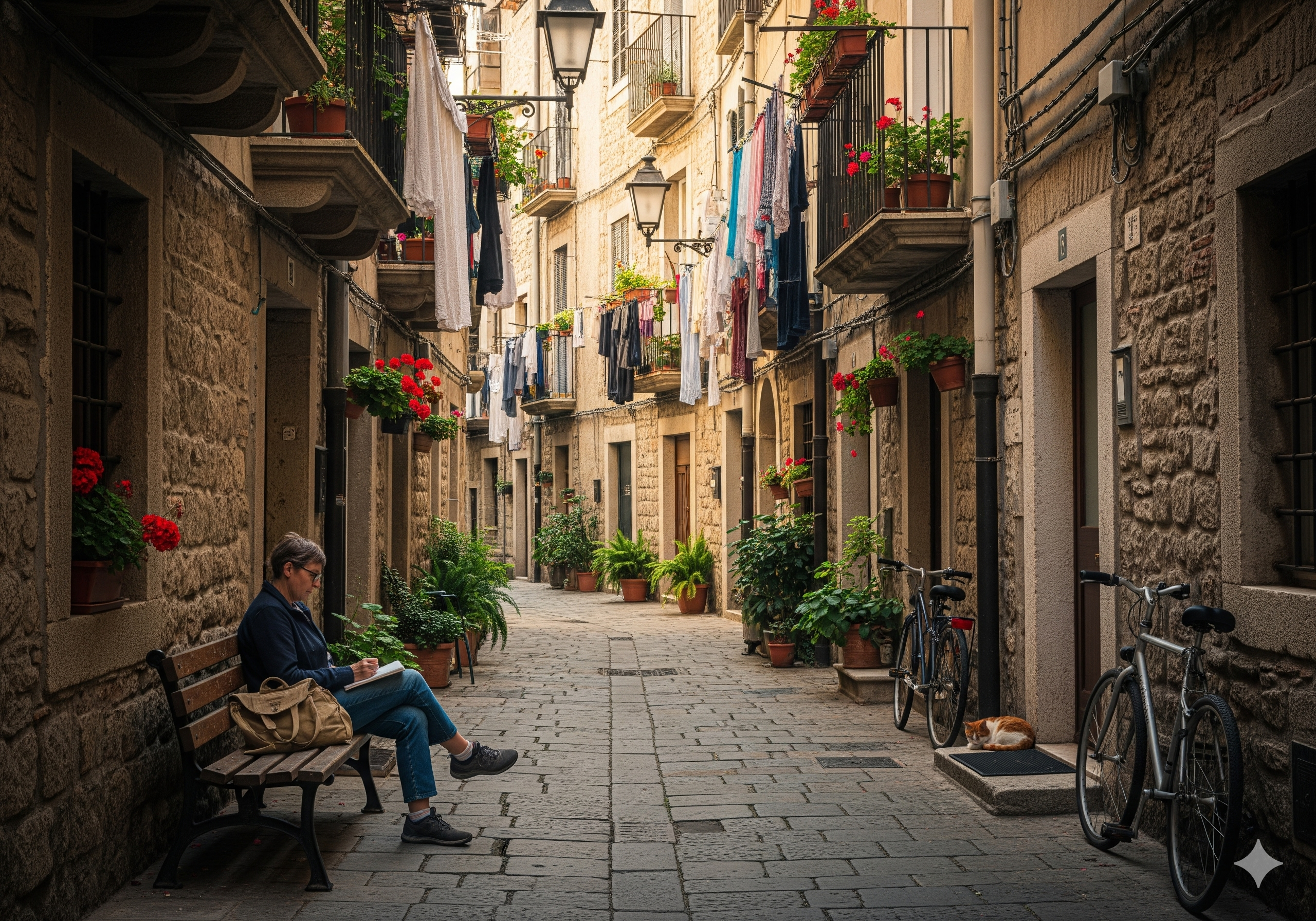Remember that feeling? The whirlwind trip where you hit five cities in seven days, raced from one landmark to the next, and collapsed into bed each night, exhausted but with a camera roll full of photos to prove you were there? It was the quintessential modern vacation—a sprint to see everything, a race against the clock. We were told this was the way to do it, the most efficient use of our precious vacation time.
But what if that whole approach is a relic of the past? What if the true luxury of travel isn’t about how many places you can tick off your list, but about how deeply you can immerse yourself in just one? The frantic pace of modern life has led to a counter-movement, a quiet rebellion against the “collect-it-all” travel philosophy. It’s called slow travel, and it’s fast becoming the new gold standard for those who seek something more meaningful from their journeys.
In an age of instant gratification, the ability to slow down and savor an experience is the ultimate form of indulgence. Why slow travel is becoming the new luxury experience isn’t just a trend; it’s a profound shift in values, where we prioritize authentic connection and personal well-being over a perfectly curated itinerary. This article will explore the philosophy behind slow travel, its tangible benefits, and why it might just be the most enriching way to see the world.
Background and Context: The Shift from Quantity to Quality
Travel has always been a mirror of its time. The grand tours of the 17th century were leisurely, months-long affairs for the elite to immerse themselves in culture. The advent of mass air travel in the 20th century democratized this experience, but it also ushered in the era of the tourist. We traded deep immersion for a checklist of sights, becoming observers rather than participants.
For decades, the standard vacation model was a compressed, high-stress endeavor. We’d save up all year for a few weeks off, only to spend them in a state of perpetual motion. We’d book flights, hotels, and tours back-to-back, leaving no room for spontaneity or genuine connection. This fast-paced, “tourist-as-consumer” model has left many feeling exhausted and unfulfilled, returning home with more stress than they left with.
The digital age, with its constant connectivity and a 24/7 “hustle culture,” has only exacerbated this feeling of burnout. We are trained to optimize every minute, and our vacations have not been spared. This has led to a yearning for something different—a way to truly disconnect, to find rest not just for our bodies, but for our minds and souls. The answer for many is slow travel. It’s a philosophy that aligns with the growing appreciation for mindfulness, minimalism, and sustainable living. It’s not just about a change of pace; it’s about a change in mindset.
The Philosophical Core of Slow Travel
At its heart, slow travel is a return to a more human way of moving through the world. It’s an act of defiance against the pressure to see and do everything. The core principle is simple: instead of rushing through a dozen cities in a month, you spend a month in just one or two. This allows you to move beyond the tourist façade and into the rhythm of daily life.
By settling into a place, you gain the time to visit the local market, learn a few phrases of the language, and discover the hidden coffee shop or park that isn’t in any guidebook. You become a temporary resident, not a fleeting visitor. The luxury here is not a five-star hotel, but the time to live like a local. It’s about being able to say, “I have the time,” instead of “I don’t have enough time.” This is the fundamental reason why slow travel is becoming the new luxury experience.
Detailed Comparison: Slow Travel vs. Fast Travel
To truly appreciate the value of a slow travel approach, let’s compare it directly to the fast travel model we’ve all become accustomed to.
| Aspect | Fast Travel | Slow Travel |
| Pace & Rhythm | Rushed. A hectic itinerary of scheduled tours, museum visits, and inter-city travel. | Mindful. A relaxed pace that allows for spontaneity, exploration, and rest days. |
| Focus | Acquisition. Ticking off landmarks, collecting souvenir photos, and amassing a list of places visited. | Immersion. Gaining a deep understanding of a single culture, connecting with locals, and experiencing daily life. |
| Financial Cost | High per experience. More expensive flights, nightly hotel fees, and tourist-trap prices. | Lower per experience. Cheaper long-term rentals, savings on cooking at home, and access to local prices. |
| Environmental Impact | High. Frequent flights, car rentals, and a larger carbon footprint. | Lower. Fewer long-distance trips, greater use of public transport, and a reduced footprint. |
| Mental State | Stressed. A feeling of being rushed, overwhelmed by logistics, and disconnected. | Relaxed. A sense of calm, curiosity, and presence that fosters true rest and rejuvenation. |
| Memories | Visual. A collection of photos and fleeting mental snapshots. | Experiential. Lasting memories of conversations with locals, daily routines, and a true sense of belonging. |
| Accommodation | Hotels. Impersonal, transient, and often expensive. | Short-term rentals. A “home away from home” that allows for a more authentic living experience. |
Export to Sheets
Key Features and Benefits That Define This New Luxury
The “luxury” of slow travel is not about thread counts or private jets. It’s about a different kind of wealth—the wealth of time, experience, and connection.
1. Immersive Cultural Experience and Authentic Connection
This is the heart of slow travel. By staying in a single location for weeks or even months, you move beyond the tourist trail. You start recognizing faces in the neighborhood, the barista remembers your order, and you find a favorite bench in the local park. This familiarity creates a space for genuine connection with locals. You might be invited to a family dinner, learn a recipe from a shopkeeper, or get advice on the best day hikes. These moments are impossible to schedule and are far more valuable than a hurried photo in front of a landmark. They are the true gems of travel.
2. Sustainable and Responsible Tourism
Fast travel, with its reliance on frequent flights and transient consumption, has a significant environmental and social impact. Slow travel, by its very nature, is a more sustainable approach.
- Lower Carbon Footprint: By reducing the number of long-haul flights, you drastically cut down on your environmental impact. When you do travel, you are more likely to use public transport, bicycles, or walk.
- Support for Local Economies: Spending an extended period in one place means your money goes directly to local businesses, from the family-run restaurant to the small artisan shop. This directly supports the community you are visiting rather than fueling large, multinational corporations.
- Reduced Over-Tourism: Instead of contributing to the crowds in already-overburdened tourist hotspots, slow travelers have the time to explore less-visited areas, spreading the economic benefits of tourism more evenly.
3. Unlocking True Rest and Mental Clarity
The relentless pace of modern life leaves many of us in a constant state of low-grade anxiety. Slow travel acts as a powerful antidote. By removing the pressure of a packed itinerary, you give your mind space to breathe. You can spend an entire afternoon reading a book in a cafe, wander without a destination in mind, or simply sit and watch the world go by. This kind of unstructured time is essential for mental well-being and allows you to return home feeling genuinely rested and rejuvenated, not just tired from your “break.”
4. The Economics of Time
It might seem counterintuitive, but slow travel is often more affordable in the long run. The per-day cost of travel can decrease significantly when you stay in a place for an extended period.
- Accommodation: Long-term rentals (weeks or months) are almost always cheaper than nightly hotel rates. You can find fully furnished apartments with kitchens, which leads to…
- Food Savings: Eating out three times a day at tourist restaurants is a major expense. With a kitchen, you can shop at local markets and cook your own meals, an immersive cultural experience in itself and a huge money saver.
- Local Prices: As you get to know a place, you learn where the locals shop and eat, avoiding the inflated prices of tourist-centric businesses.
Pros and Cons of a Slow Travel Lifestyle
Like any philosophy, slow travel has its strengths and weaknesses. It’s not for everyone, and it’s important to weigh the trade-offs.
Pros:
- Authentic Experiences: You get to see the real side of a place, not just the highlights.
- Cost-Effective: Often cheaper per day than traditional tourism due to long-term living.
- Deeper Connections: You have the time and opportunity to form relationships with locals and other travelers.
- Reduced Stress: Without a strict schedule, you can be spontaneous and truly relax.
- Personal Growth: Stepping out of your comfort zone for an extended period can lead to significant self-discovery.
- Environmental Responsibility: A more sustainable way to see the world.
Cons:
- Requires More Time: This is the biggest hurdle. Not everyone has the luxury of taking weeks or months off work.
- Less Variety: You sacrifice the ability to see multiple destinations in a short period. You may only visit one country instead of five.
- Initial Planning: While the daily pace is slower, the initial planning (finding a long-term rental, visas, etc.) can be more involved.
- Can Be Lonely: Being in a new place for an extended period can be isolating at first if you don’t actively seek out community.
- Not for the “Collector”: If your primary goal is to “see everything,” this style of travel will likely feel frustrating and unfulfilling.
Use Cases: Who Should Embrace Slow Travel?
Slow travel is not just for gap-year students or retirees. It is a flexible philosophy that can be adapted by a wide range of people.
- The Digital Nomad: This is perhaps the most obvious use case. With the ability to work remotely, a digital nomad can settle into a city like Lisbon, Buenos Aires, or Chiang Mai for a few months at a time, living and working as they explore.
- The Family Sabbatical: Parents with school-aged children can take a semester or year off to travel. This provides an incredible educational opportunity, allowing children to learn a new language, experience different cultures, and see history come alive.
- The Sabbatical Taker: Many companies now offer sabbaticals. Instead of trying to squeeze a vacation into a few weeks, an employee can use this extended time to truly immerse themselves in a new culture.
- The Weekend Warrior (on a smaller scale): You can apply the slow travel philosophy to shorter trips. Instead of taking three long weekends a year, take one long weekend and spend all three days in a single neighborhood of a nearby city, exploring it on foot.
FAQs: Answering Your Questions on the New Luxury of Travel
What is slow travel and is it for me?
Slow travel is a philosophy of traveling at a more leisurely pace, prioritizing immersion and connection over a packed itinerary. It’s for you if you feel rushed and unfulfilled by traditional vacations, value authentic experiences over seeing famous landmarks, and want to truly understand a place and its people.
How do you plan a slow travel trip?
The planning for slow travel is less about an hour-by-hour itinerary and more about finding the right “home base.” Start by researching a single city or region that fascinates you. Look for long-term rental options (Airbnb, Vrbo, etc.), research the visa requirements for your intended length of stay, and learn about the local public transport system. The key is to plan less and live more once you arrive.
Is slow travel more expensive than fast travel?
On a per-day basis, slow travel is often significantly cheaper. While the initial cost of a long-haul flight is high, you save money on the ground through long-term rentals, cooking at home, and accessing local prices. Over a month, the total cost can be less than a week-long, fast-paced trip.
What are the best destinations for slow travel?
The best destinations are places with good public transportation, a rich local culture, and a reasonable cost of living. Some popular examples include Lisbon (Portugal), Buenos Aires (Argentina), Berlin (Germany), Hoi An (Vietnam), and Oaxaca (Mexico). The best place, however, is simply somewhere you feel you could be happy living for a while.
How does slow travel benefit mental health?
By removing the pressure to “do it all,” slow travel reduces stress and anxiety. It fosters mindfulness, as you are present in the moment rather than worried about the next item on your list. The lack of constant sensory overload from moving from place to place allows your mind to truly rest and rejuvenate.
Conclusion: The New Definition of Luxury
For decades, we’ve been told that luxury travel means opulence, speed, and exclusivity. It meant a first-class ticket, a suite with a view, and a private tour guide. But in a world where everyone is exhausted and time is our most precious commodity, the definition of luxury is changing.
The new luxury is the ability to take your time. It is the wealth of a week spent lingering in a single neighborhood, getting to know the rhythm of its daily life. It’s the indulgence of an afternoon with no plans, allowing for spontaneous discovery. It’s the experience of feeling like a resident, not a visitor. This is why slow travel is becoming the new luxury experience. It offers what money can no longer buy: presence, peace, and authentic connection.
Final Verdict
Slow travel isn’t just a niche travel trend; it’s a fundamental shift in how we approach our most precious resource: time. It is a philosophy that offers a deeper, more meaningful, and ultimately more enriching way to engage with the world. While it requires a greater initial investment of time, the emotional, cultural, and mental rewards are immeasurable. For those who are tired of the constant rush and long to find true rest and connection, slow travel isn’t just an option—it’s the new gold standard. It’s not just a way to see the world; it’s a way to truly live in it.







Leave a Reply